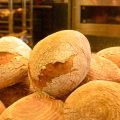So you’ve found yourself with an over-proofed sourdough, huh? Don’t sweat it! It’s definitely not the end of the world. Your sourdough isn’t ruined, I promise! In fact, we can totally turn this ship around. Now, I know some folks out there might tell you to toss that dough and start from scratch. But hold up! There’s no need to waste all that delicious potential. Your over-proofed sourdough is absolutely still good to eat, and with a few tricks up our sleeves, we can salvage it into something tasty. Ready to rescue that loaf? Great! Let’s roll up our sleeves and dive into some easy steps to save your sourdough. And hey, while we’re at it, we’ll figure out how to avoid this little hiccup in the future.

Table of Contents
- What is Proofing?
- Causes of Overproofing
- How Can You Tell if Your Sourdough is Done Proofing?
- Signs Your Dough is Overproofed
- Saving Overproofed Dough
- Effects of Overproofing on Final Bread
- Tips to Prevent Overproofing
- Testing Your OverProofed Sourdough
- Common Myths
- Adjusting Recipes
- Ways to Use Overproofed Sourdough Bread
- What About Under-Proofed Sourdough?
- Rescuing Over-Proofed Sourdough
- FAQs
What is Proofing?
Proofing is another word for fermentation. It refers to the time given for the yeast and bacteria in the dough to undergo fermentation and produce gasses allowing the dough to rise.
Proofing plays an important role in determining the volume, crust and structure of the crumb.
There are two stages of proofing and these include:
- Bulk Fermentation – This is the first stage of proofing, which takes place after the dough has been mixed.
- Final Fermentation – This is the second stage of proofing, which takes place after the dough has been shaped.
Related Read: Why is My Sourdough Bread Gummy?
Causes of Overproofing
Environmental Factors
Temperature and humidity significantly influence sourdough behavior. High temperatures accelerate fermentation, potentially leading to overproofing. On hot days, yeast activity increases rapidly, speeding up the proofing process.
Humidity also affects proofing. Excess moisture in the air can cause dough to absorb extra water, altering the carefully calculated flour-to-water ratio. This can lead to unexpected changes in proofing time and dough consistency.
Time Troubles
Accurate timing is crucial in sourdough baking, and misjudgments can easily lead to overproofing. Distractions or underestimating rise time can result in dough fermenting longer than intended.
Sourdough doesn’t follow a strict timeline. Factors like starter strength and flour type influence proofing duration. This variability requires constant attention and adjustment.
Yeast Gone Wild
Sourdough starters contain wild yeast and bacteria. An overly active starter or using too much starter in your dough can accelerate fermentation. In these cases, yeast consume available sugars quickly, resulting in overproofed dough.
Achieving the right balance is key. You need enough yeast activity to create bubbles and develop flavor, but not so much that fermentation occurs too rapidly.
The Flour Factor
Flour choice impacts proofing time. Whole grain flours generally ferment faster due to higher enzyme content. Switching from all-purpose to whole wheat flour without adjusting proofing time can lead to overproofing.
How Can You Tell if Your Sourdough is Done Proofing?
The main task during the proofing of sourdough, is patiently waiting for the carbon dioxide gasses to gather and rise the dough. This can take anywhere from 8-14 hours depending on several factors: your flour, temperature and humidity level. This is because the yeast works faster in warmer temperatures.
The dough will have completed proofing once it achieves a 30% rise during bulk fermentation and an additional 30% rise of the dough during final fermentation.
You can observe the rise of the dough during bulk fermentation by placing the dough in a transparent square container that has the same width throughout its height, and measuring the rise with a ruler.
Signs Your Dough is Overproofed
Knowing the basic methods of telling whether your dough is over-proofed or not can be quite handy. Here are a couple of obvious ways to catch an over-proofed dough:
The Dough Smells Like Alcohol
If you’re struggling with the tell-tale signs of an over-proofed sourdough, I got you!
The best way to determine this is through smelling your dough. A major sign that your dough is over-proofed is when you smell your dough and the dough smells slightly like alcohol.
If the bread has this distinctive odor, then it is probably over-proofed and will most likely collapse when baked in the oven, due to lack of structure and strength.
The Poke Test
The poke test is an easy way to help you decide whether your dough is over-proofed or not.
The method is straightforward, simply uncover your dough and press one or two fingers into the surface of it for around 2 seconds. Then remove your fingers and watch how much of an indentation remains in the dough. If you notice that the dough does not spring back into place and stays put, then your dough has lost its elasticity, meaning that it is over-proofed.
Saving Overproofed Dough
An over-proofed sourdough is a little hard to save, depending on how over-proofed it is.
Some signs of an over proofed sourdough include a flatter dough structure that has collapsed at the sides of the bowl.
Fortunately, there is a way to fix this.
Try giving your sourdough some stretches and folds with your hands, moving the dough around the bowl. This will give the dough a chance to find some new pockets of sugars and starches to consume. Follow this up by letting your starter prove again for another 2 hours before shaping up into loaves or buns as normal.
Another sign is a loose and slack dough, which doesn’t surrender to any shape you try to force it into, is from pulling them up towards yourself or folding them over on themselves. You’ll notice that the dough will just fall back down in droopy clumps onto itself. This is also known as being heavily over-proofed, meaning there’s very little left that could possibly be saved without baking something right then and there – even if you were able to get some kind of shape out of it!
The only thing left would be to pour the shapeless batter into greased loaf tins with hopes that they’d magically transform into structured loaves after baking; which most likely won’t happen since these breads tend to emerge as a dense loaf, rather than soft and fluffy.
With the final result giving a denser flatter breads that taste extremely sour, you’ll find that these are great for making croutons or using in bruschetta toppings.
Effects of Overproofing on Final Bread
Crumb Structure Issues
Instead of an even, well-distributed texture, you’ll likely end up with an inconsistent crumb. The bread may have large, irregular air pockets, especially towards the top of the loaf. Meanwhile, the bottom can become dense and gummy. This uneven distribution of air bubbles results in a less appealing texture and can make the bread difficult to slice or use for sandwiches.
Crust Problems
Properly proofed sourdough typically develops a thick, crispy crust during baking. However, overproofed bread often produces a thinner, paler crust that lacks the desired crispness. This crust may become flaky or brittle rather than providing the satisfying crunch associated with well-made sourdough.
Flavor Alterations
While sourdough is known for its tangy flavor, overproofed loaves can become unpleasantly sour. This happens because the extended fermentation time allows the wild yeasts and bacteria to produce more acid than usual. The result is a bread with an overpowering sour taste that may overpower other flavors and be less enjoyable to eat.
Reduced Oven Spring
Oven spring, the rapid rise of bread when it first enters a hot oven, is significantly impacted by overproofing. Overproofed dough has exhausted much of its rising potential before it even reaches the oven. As a result, you may observe minimal rise during baking, or in severe cases, the loaf might even collapse. This leads to a flatter, denser bread that lacks the desired height and open crumb structure of properly proofed sourdough.
Tips to Prevent Overproofing
Monitor your dough closely and learn to recognize proper fermentation signs. Check your dough every 30 minutes during bulk fermentation. Look for a 30-50% increase in volume and a slightly domed surface. If you’re new to sourdough, set a timer to remind you to check on your dough regularly.
Cold retarding is effective for preventing overproofing. Refrigerating your dough slows down fermentation, giving you more control over the process. This technique is useful if you’re not ready to bake or want to develop more flavor. Remember to allow extra time for the dough to return to room temperature before baking.
Proper dough handling is important. When shaping your loaves, be careful not to remove too much air. Overly aggressive handling can result in a dense loaf that doesn’t rise properly. Handle your dough firmly but gently during shaping.
Your kitchen’s climate significantly affects proofing. In hot weather, your dough will ferment faster. On hot days, use cooler water in your dough or find a cooler spot for proofing. In cold weather, you might need to create a warm, draft-free area to encourage proper fermentation.
The poke test is an important tool against overproofing. Gently poke your finger about 1/2 inch into the dough. If it springs back quickly, it needs more time. If it springs back slowly and leaves a small indentation, it’s ready to bake. If the dent doesn’t spring back at all, you’ve overproofed – but don’t worry. You can still salvage it by reshaping and giving it a short second rise.

Testing Your OverProofed Sourdough
You can test your over-proofed dough to determine its consistency. If you are unsure how to tell if your sourdough has gone bad, by performing the following tests:
The Indentation Test
This is a simple technique that you can use to determine if your dough has been over-proofed.
While the dough is in its container press down on the dough with your finger for a couple seconds. If after removing your finger, the indentation remains, then you know that your sourdough needs to be rescued. The yeast has exhausted itself and stopped working as it should be.
If however when you press down on your sourdough and release, it reacts by springing back into place and returning to its original shape, then this means that your starter has not become over-proofed yet. You can still bake it normally without any extra precautions needed!
The Spread Test
Over-proofed sourdough will spread more than normal. You can test this by removing it from its original container, and flipping it into another.
If the dough immediately starts to spread, even a little, then this is an indication that the dough has over-proofed (which happens as the gluten strains lose their elasticity and the dough is unable to hold its structure). Normal bread will be fuller and maintain any shape you store it in
The De-Gas Test
The de-gas test is a great way to determine whether your dough is over-proofed or not. This test can be done by gently tapping on the top of the loaf.
If it has been properly proofed, there will be gas bubbles that appear on its surface. They may instantly deflate as soon as your knuckles touch the dough, with a light rap.
An over-proofed dough will be firm and you won’t be able to de-gas it further. There will now be no additional gas to escape from the dough. This will result in an indentation in the place where you tapped the loaf.
The Slice Test
The slice test is a good way to check if your dough is over-proofed. If you have already mixed up your sourdough starter and you want to know if your bread has risen enough, then cut into the center of it with a sharp knife. If it cuts through with ease, then this means that it has over-proofed. Try not to slice too much off or else the overall texture of your bread will be ruined.
If instead when using a sharp knife on top of the loaf, it does not cut right through but causes an indentation in the loaf without any resistance (this may also happen if you are trying to make slices while still hot), then this indicates under-proofing which can lead to sunken areas on top.
Common Myths
Myth: Overproofed Dough is Always Ruined
Let’s clear this up: the idea that overproofed sourdough is destined for the trash bin is incorrect. While it’s not ideal, you can often salvage overproofed dough. A quick reshape and a short second rise can significantly improve the situation. It’s about giving your dough another opportunity to succeed.
Myth: You Can’t Overproof in the Fridge
This is a common misconception. While cold fermentation (also known as retarding) slows down the proofing process, it doesn’t stop it completely. Your dough can still overproof in the fridge, especially if left for too long. The process continues, albeit at a slower rate.
Myth: Overproofed Dough Always Tastes Super Sour
Here’s an interesting fact: overproofed doesn’t automatically mean excessively sour. The sourness in sourdough comes from lactic and acetic acids produced during fermentation. While overproofing can increase acidity, it’s not a guarantee of an overly sour loaf. Temperature plays a crucial role – cooler temperatures tend to produce more acetic acid (sharper taste), while warmer temperatures favor lactic acid (milder, yogurt-like tang).
Myth: You Can Tell if Dough is Overproofed Just by Looking
This isn’t accurate. While an overproofed dough might look extra bubbly or flatten out, visual cues alone aren’t reliable. The true test is in the feel and behavior of the dough. That’s where the poke test proves valuable. It’s not just about appearance, but how the dough responds to touch.
Myth: Overproofing Only Happens During the Final Rise
This is incorrect: overproofing can happen at any stage of fermentation, including the bulk ferment. While it’s more common during the final proof, neglecting your dough during the bulk fermentation can lead to over-fermentation, which is essentially the same as overproofing. It’s important to monitor your dough throughout the entire process.
Adjusting Recipes
To address overproofing issues, consider adjusting your ingredient ratios.
One effective strategy is to reduce the amount of starter in your recipe. Instead of using 20-25% starter, try reducing it to 15-18%. This slight decrease can provide more control over fermentation times without compromising flavor.
Another useful adjustment involves modifying salt levels. Salt slows down fermentation. Increasing your salt content by just 0.5% can notably impact proofing speed. However, be cautious not to add too much, as it can affect the taste and texture of your bread.
Sometimes, adjusting fermentation times is more effective than changing ingredients. In warmer environments, consider shortening your bulk fermentation time. Rather than leaving your dough out for 4-5 hours, check it after 3 hours. It may be ready for shaping sooner than expected.
For the final proof, utilizing your refrigerator can be beneficial. Cold fermentation slows down the process, giving you more flexibility and helping prevent overproofing. This method also enhances flavor development in your bread.
Your choice of flour significantly impacts proofing times. Whole grain flours accelerate fermentation. If you’re consistently experiencing overproofing, try replacing some whole wheat flour with bread flour. This substitution can slow down fermentation without significantly altering taste or texture.
On particularly warm days when fermentation seems rapid, consider incorporating a small amount of rye flour. Rye has enzymes that can help regulate fermentation rates. Adding just 5-10% of your total flour weight as rye can make a noticeable difference.
Ways to Use Overproofed Sourdough Bread
Transform It Into Crunchy Croutons
If you have a loaf that’s too sour or flat, don’t discard it. Instead, slice the bread into cubes, toss with olive oil and your favorite herbs, then bake until golden. You’ll have homemade croutons that will add a tangy crunch to salads or soups. For extra flavor, try mixing in some grated Parmesan before baking.
Whip Up a Decadent Bread Pudding
Overproofed sourdough works well in bread pudding. Its tanginess enhances the flavor of this classic comfort food. Cube the bread, soak it in a mixture of eggs, milk, and sugar, then bake until the inside is custardy and the top is crispy. For variety, add chocolate chips or dried fruit.
Create the Ultimate French Toast
French toast made with overproofed sourdough can be exceptional. Use thick slices for a memorable breakfast. The bread’s natural tang complements maple syrup and powdered sugar well. For a savory version, try topping it with a fried egg and crispy bacon.
Make Your Own Breadcrumbs
Homemade breadcrumbs from overproofed sourdough can significantly improve many dishes. Dry out the bread in a low-temperature oven, then process it in a food processor. These tangy crumbs work well for coating chicken, topping mac and cheese, or adding texture to casseroles. Storing them in the freezer ensures you always have them on hand.
Rustic Panzanella Salad
Overproofed sourdough is ideal for panzanella, a Tuscan bread salad that’s popular in summer. Cube the bread, toast it lightly, then combine with tomatoes, cucumbers, and a zesty vinaigrette. The bread absorbs the flavors of the other ingredients, resulting in a tasty and satisfying dish.
What About Under-Proofed Sourdough?
While under-proofing is more forgiving than over-proofing, it does have its drawbacks.
The bread won’t develop as much flavor and will have a bit of an uneven crumb after baking. This can be observed through the very large holes at the top of the loaf, and much smaller ones at the bottom.
In addition to this more basic issue with texture, there’s also a difference in flavor profile between under-proofed and over-proofed breads. While both will still taste good when baked, an under-proofed dough will lack some depth compared to one that was left to rise for longer – something that could be described as being more plain or simple in terms of taste profile.
Rescuing Over-Proofed Sourdough
Having an over-proofed sourdough happens to the best of us, and is definitely not the end of the world. Sometimes it can be fixed to create that almost perfectly baked sourdough bread. Other times you may have baked a loaf with an uneven crumb, and blander flavor profile.
Trial and error, is the key to success!
Speaking of trying, why not begin with these recipes?
FAQs
What Happens if Sourdough is Over-Proofed?
An over-proofed sourdough would mean that your dough won’t rise in the oven, causing it to deflate easily as you flip it into a baking tray.
How do You Know if you Over-Proofed Sourdough?
You can press into the dough, to test whether your sourdough is over-proofed. If it leaves a permanent indentation, it is over-proofed.
Can Over-Proofed Sourdough be Saved?
Try gently punching it, and reshaping it, then baking it immediately.
How do You Know if Bread is Over-Proofed?
Over-proofed bread releases a distinct odor, and falls apart easily when you pull at it.

![Batard Sourdough Shaping [Your Ultimate Guide] 3 Batard sourdough shaping [the ultimate guide]](https://www.mydailysourdoughbread.com/wp-content/uploads/2022/12/CD-blog-images-2023-01-05T184157.343-120x120.jpg)


![How To Cold Proof Sourdough [Your Easy Guide] 6 How to cold proof sourdough [your easy guide]](https://www.mydailysourdoughbread.com/wp-content/uploads/2023/01/blog-images-40-120x120.jpg)

